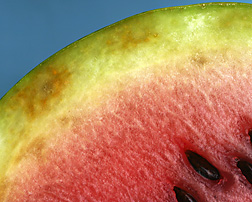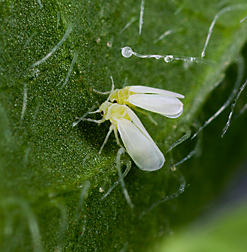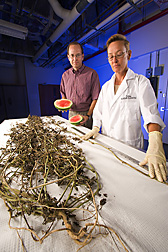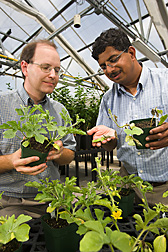On Guard Against Watermelon Vine Decline
|
|
Deep in winter, we dream of summertime and delicious outdoor picnics filled with hot dogs, lemonade, and refreshing watermelon. But the availability of that popular, nutritious fruit could be drastically affected by a looming new threat.
Watermelon vine decline—or WVD—is a crippling disease of watermelon that has made a serious economic impact since first being seen in Florida in May 2003. So far, it has been limited to the Sunshine State, but commercial watermelon growers fear that it could spread to other states.
Research efforts led by plant pathologist Scott Adkins at the ARS Subtropical Plant Pathology Research Unit in Fort Pierce, Florida, have focused on pinpointing the cause of the disease and finding ways to curb it.
Hidden Menace
Looks are deceiving when watermelons first come under attack by WVD because there are no external symptoms on the fruit itself. Then, suddenly, there’s wilting, browning, and loss of leaves, followed by rapid vine collapse and death just before harvest. While the outside of infected watermelons may appear normal, the interior often shows browning. The flesh appers greasy and has a bad taste, making the fruit unmarketable.
Spread of the disease has been very rapid. In some fields, vine decline has increased from 10 percent of the plants to more than 80 percent in just 1 week.
|
|
In 2002, before the WVD assault, Florida was ranked first in watermelon production, with 15 percent of U.S. watermelon acreage and 19 percent of total production and value. Since spring 2003, WVD has afflicted sections of southwest Florida and has moved into west-central Florida. In spring 2004, some growers lost more than half their harvest, and others have since lost their entire fields.
In fact, damage and yield losses exceeded $60 million in 2005 alone, further driving interest in WVD research. As a result of the declining output, Florida has relinquished its number-one spot to Texas.
“The disease has been so severe and caused such economic losses that Florida watermelon farmers have been seriously considering switching to other crops,” says Adkins.
First, Find the Culprit
Nonbiological factors, bacteria, and fungi had been eliminated as the cause of WVD by other researchers. Then Adkins—in collaboration with Susan Webb, a University of Florida (UFL) entomologist, and Carlye Baker, a plant pathologist with the Florida Department of Agriculture and Consumer Services, Division of Plant Industry—found that the cause is a new virus known as “squash vein yellowing virus” (SqVYV). The SqVYV seems to infect plants in only the Cucurbitaceae family, with the most dramatic symptoms occurring on squash and watermelon.
|
|
It had been known for some time that the principal insect pests on watermelons in Florida were aphids, rindworms, whiteflies, and thrips, but it took 2 years of research to realize that SqVYV transmitted by the silverleaf whitefly, Bemisia tabaci, was responsible for WVD.
This research involved both extensive molecular lab analyses of the virus under controlled conditions and field trials, in collaboration with plant pathologist Pam Roberts and entomologist Phil Stansly, both at UFL, to examine the role of whitefly populations and insecticides on disease incidence.
In the spring of 2007, cucurbit leaf crumple virus (CuLCrV), another whitefly-transmitted virus, was found infecting watermelons in southwest Florida. The same team of scientists studying WVD made the discovery. CuLCrV had previously been reported in the western United States, and its recent appearance in Florida further highlights the importance of whitefly management.
|
|
Next, Figure Out What To Do
Plant pathologist Benny Bruton has worked with Adkins since the initial stages of WVD research, and plant pathologist Shaker Kousik joined the effort in November 2005. Bruton is at ARS’s South Central Agricultural Research Laboratory in Lane, Oklahoma, and Kousik is at the U.S. Vegetable Laboratory in Charleston, South Carolina. Bruton isolated many bacteria and fungi and inoculated melons with the suspect microbes to see if they might be involved in the vine-decline syndrome.
“It was a long and painful process to identify which microbes may cause, or even contribute to, the disease—really a process of elimination,” says Bruton. “Once Scott’s team found the unusual virus and was able to demonstrate that it could cause essentially all the symptoms of vine decline—and that it was whitefly transmitted—it became essential to develop an integrated approach to manage or control the disease.”
Together, Kousik, Bruton, and Adkins have been taking a nontraditional approach: grafting watermelon onto gourd rootstock. Bruton and other researchers have had excellent results in controlling fungal vine declines of watermelon, such as Verticillium wilt, caused by Verticillium dahliae, and Fusarium wilt, caused by Fusarium oxysporum. The researchers wanted to see whether grafted transplants would also be resistant to, or tolerant of, the new viral vine decline. They have been testing grafted watermelons in several farmers’ fields in Florida, in field trials with UFL scientists, and in greenhouse trials in Fort Pierce.
Also, Kousik and Adkins have been screening watermelon germplasm for resistance to SqVYV in the greenhouse and field in Florida. They have identified several potential sources of resistance in wild-type watermelon. The germplasm was obtained from the ARS Plant Genetic Resources Conservation Unit at Griffin, Georgia. Kousik is also evaluating combinations of insecticides and silver plastic mulch to manage whitefly populations and thus WVD.
The Florida Watermelon Association and the National Watermelon Association have been very supportive of this collaborative research effort, greatly speeding up its success.—By Alfredo Flores, Agricultural Research Service Information Staff.
This research is part of Plant Diseases, an ARS national program (#303) described on the World Wide Web at www.nps.ars.usda.gov.
Scott T. Adkins is in the USDA-ARS Subtropical Plant Pathology Research Unit, 2001 South Rock Rd., Fort Pierce, FL 34945; phone (772) 462-5885, fax (772) 462-5986.
Benny Bruton is with the USDA-ARS South Central Agricultural Research Laboratory, P.O. Box 159, Lane, OK 74555; phone (580) 889-7395, fax (580) 889-5783.
Shaker Kousik is with the USDA-ARS U.S. Vegetable Laboratory, 2700 Savannah Hwy., Charleston, SC 29414; phone (843) 402-5316, fax (843) 573-4715.
"On Guard Against Watermelon Vine Decline" was published in the November/December 2007 issue of Agricultural Research magazine.










